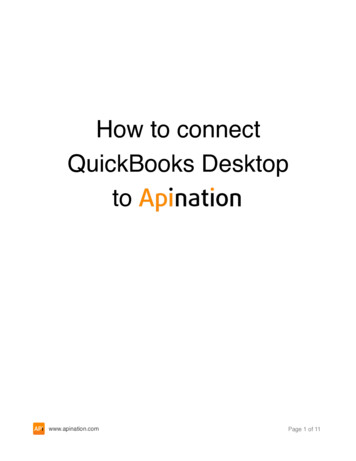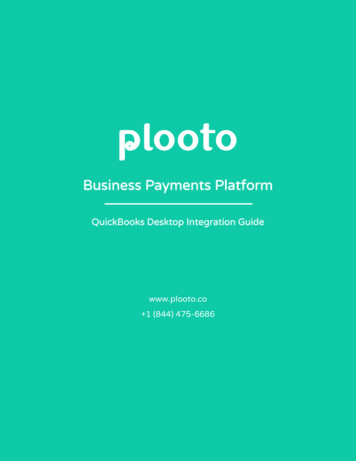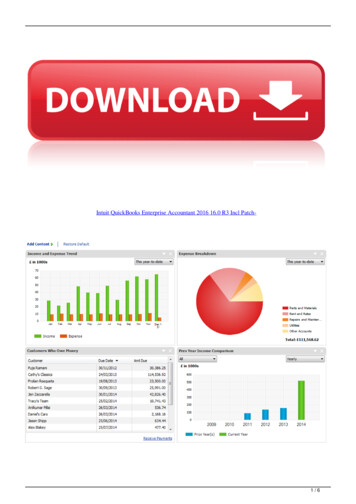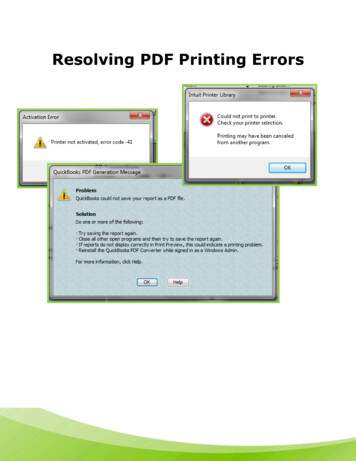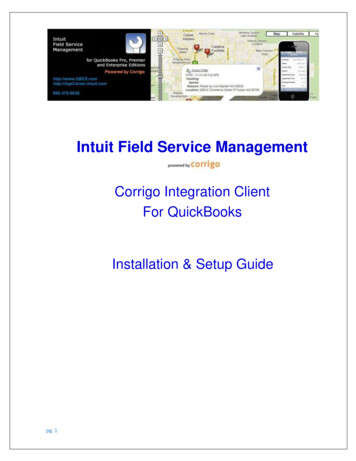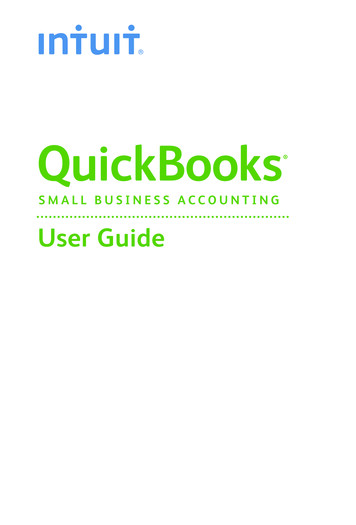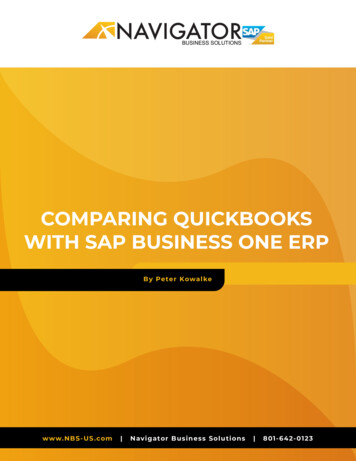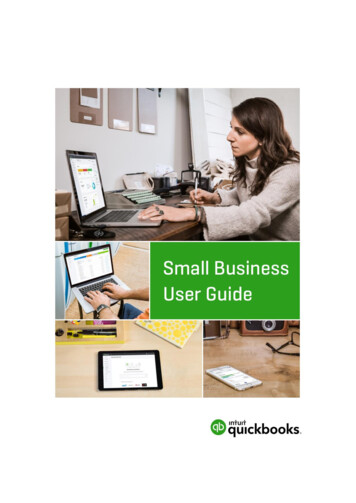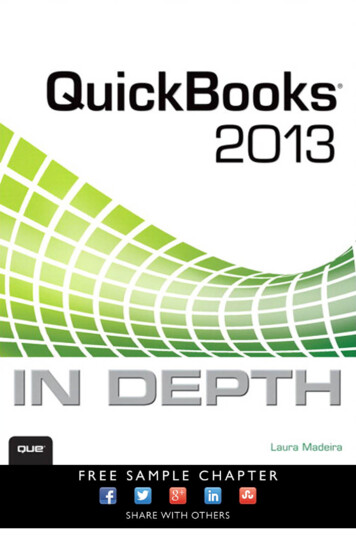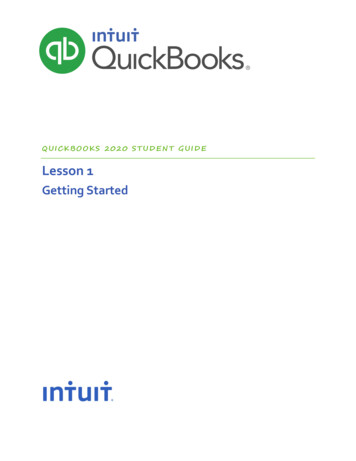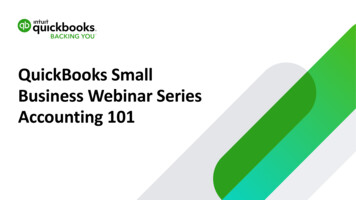
Transcription
QuickBooks SmallBusiness Webinar SeriesAccounting 101
Agenda1. What is accounting? Why do we do accounting?2. Introduction to Financial Statements3. Chart of Accounts Connecting Financial Statements to your Chart of Accounts Account Types Account Setup4. Tips, Tricks, and Best Practices Using Subaccounts Working with your chart of accounts5. Q & A2Intuit Confidential and Proprietary
What is Accounting?
What is accounting?System for recording business and financial transactions in a business and reporting on thosetransactionsTwo types of accounting Financial Accounting – deals with information for external bodies like CRAManagerial Accounting – used for internal decision making by small business ownersWhy do we do accounting?Track business transactionsReport to outside organizations like CRA for sales tax, payroll taxes, etc.Measure our business performance and business positionCreate reports to help us 4Better understand our businessMake decisionsIntuit Confidential and Proprietary
Introduction to FinancialStatements
Financial StatementsSummarize the business activities and financial performance of your small business. Theinformation is used by the readers to make business decisions.Two Key Financial Statements 6Income Statement (Profit & Loss)Balance SheetIntuit Confidential and Proprietary
Income Statement Presents the Income and expenses and the profits or losses of the business during aspecific period of time. i.e. Fiscal Year, Quarter, Month, etc. Provides us with details about the Performance of the businessIncome – Expenses Net Income7Intuit Confidential and Proprietary
Revenue or Incomerepresents sales inthe businessCost of Goods Soldrepresent a business’direct costsExpenses representyour overheadexpenses8Intuit Confidential and ProprietaryGross Profit representsprofit before youroverhead expenses aredeductedNet Income representsyour profit for aspecific period of timeor your Performance
Balance Sheet Presents the Assets, Liabilities and Equity in the business Assets – What the business Owns. Businesses use up assets to make revenue vehicles, equipment, etc. Liabilities – what the business Owes payroll liabilities, bank loans, credit cards, etc. Equity – how much money is left in the business that the owners can take out Provides us with details about the Position of the businessAssets Liabilities Equity9Intuit Confidential and Proprietary
Liabilitiesfollow assetsAssets are atthe top ofthe balancesheetEquity is laston the reportAssets Liabilities Equity10Intuit Confidential and Proprietary
Chart of Accounts
Chart of AccountsWhere do reports come from? Reports are created using the data entered in the accounting system using the Chart ofAccounts The chart of accounts is where all transactions are entered. Every transaction in QuickBooks will include the required double entry to the Chart ofAccounts. QuickBooks takes care of the double entry accounting for you.12Intuit Confidential and Proprietary
InvoicesSales ReceiptsChequesInvoicesAccounting Reports/Financial StatementsChart ofAccountsPurchase OrdersLoan PaymentsDepositsBills13Intuit Confidential and Proprietary
Connecting financial statements to your Chart of Accounts1. Financial Statements are created using your Chart of Accounts – the setup of the chart ofaccounts is directly connected to the financial statements2. The Chart of Accounts is the hub of your accounting – every transaction in QuickBooksgoes through the chart of accounts3. Customize your chart of accounts to work for your businessIncome Statement Account TypesIncome Statement accounts include: Income – revenue from your sales of products and services Cost of Goods Sold – track your direct costs of your cost of inventory Expenses – overhead expenses like rent, utilities, repairs, fuel, etc.14Intuit Confidential and Proprietary
Connecting financial statements to your Chart of AccountsBalance Sheet accounts include: Assets – things the company owns Bank Accounts – track money in your chequing or savings accounts Fixed Assets – track items like vehicles, office equipment, building, etc. Accounts Receivable – money owed to you is considered an asset Liabilities – money the company owes Credit Card accounts Accounts Payable – bills owed to suppliers Loan or notes payable – long term loans, lines of credit, notes payable, etc. Equity 15Talk to your accounting professional to determine the optimal way to setup equity accountsIntuit Confidential and Proprietary
Chart of Accounts Demo Setup
Tips, Tricks & Best Practices
Tips for your Chart of Accounts1. Account Names Keep the name short and easy to understand Don’t use supplier names. The account name should describe the account not the supplier. You can’t use duplicate account names2. Account Numbers Enable account numbers if it is your preference Accountants like account numbers3. Create subaccounts for detailed tracking4. Cleanup the Chart of accounts using the following tools:18 Edit names Delete/Make Inactive Merge duplicates or unnecessary accountsIntuit Confidential and Proprietary
Tips, Tricks, & Best PracticesDemo
Q&A
Find an AccountantIf you need to find aQuickBooks expert visitQuickBooks.ca1. Click Support2. Click Meet your match3. Enter your Postal Code4. Click Find a ProAdvisor21
Take our survey at https://www.research.net/r/Accounting101Webinar
9 Intuit Confidential and Proprietary Presents the Assets, Liabilities and Equity in the business Assets –What the business Owns.Businesses use up assets to make revenue vehicles, equipment, etc. Liabilities –what the business Owes payroll liabilities, bank loans, credit cards, etc. Equity –how much money is left in t
